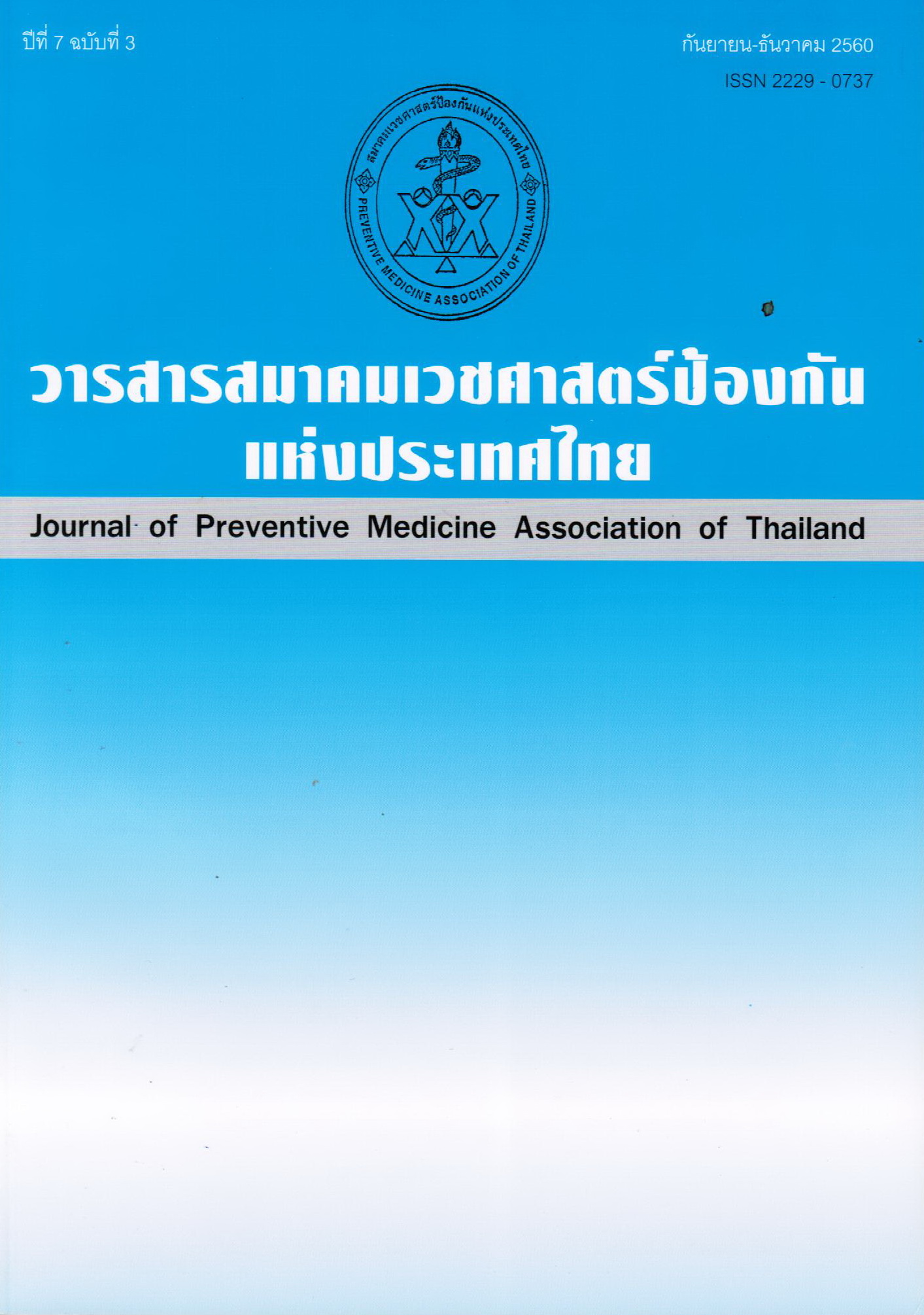ปัจจัยที่มีความสัมพันธ์ต่อการเกิดภาวะน้ำหนักเกิน ของนักเรียนประถมศึกษาโรงเรียนรัฐบาล
คำสำคัญ:
การรับรู้ความสามารถของตนเอง, การสนับสนุนทางสังคม, พฤติกรรมการป้องกันภาวะน้ำหนักเกิน, นักเรียนประถมศึกษาบทคัดย่อ
ภาวะน้ำหนักเกินของนักเรียนเป็นปัญหาสาธารณสุขที่สำคัญและมีแนวโน้มเพิ่มสูงขึ้น การศึกษาครั้งนี้เป็นการวิจัยเชิงสังเกต มีวัตถุประสงค์เพื่อศึกษาพฤติกรรมการเกิดภาวะน้ำหนักเกินของนักเรียนประถมศึกษาทำการศึกษา ในกลุ่มตัวอย่างนักเรียนประถมศึกษาปีที่ 4-6 ทั้งเพศชายและหญิง จำนวน 145 คน แบ่งเป็นกลุ่มน้ำหนักปกติ (สมส่วน, ท้วม, ค่อนข้างผอม) และกลุ่มภาวะน้ำหนักเกิน (เริ่มอ้วน, อ้วน) โดยเปรียบเทียบจากกราฟแสดงเกณฑ์อ้างอิงการเจริญเติบโต ของกรมอนามัย กระทรวงสาธารณสุข (น้ำหนักตามเกณฑ์ส่วนสูง) เครื่องมือที่ใช้เป็นแบบสอบถามที่ผู้วิจัยสร้างขึ้นประกอบด้วย ข้อมูลทั่วไป การรับรู้ความสามารถของตนเองเกี่ยวกับภาวะน้ำหนักเกินซึ่งเป็นการเชื่อมั่นความสามารถของตนเอง และเกิดความมั่นใจที่จะแสดงพฤติกรรม และการสนับสนุนทางสังคมวิเคราะห์ข้อมูลด้วยสถิติเชิงบรรยายและและการวิเคราะห์ความสัมพันธ์โดยใช้สถิติไคสแควร์
ผลการศึกษา พบว่า กลุ่มตัวอย่าง เป็นเพศหญิง ร้อยละ 50.3 เพศชาย ร้อยละ 49.7 มีอายุ 9-10 ปี ร้อยละ 55.2 รองลงมา มีอายุ 11-13 ปี ร้อยละ 44.8 มีภาวะโภชนาการอยู่ในระดับสมส่วน ร้อยละ 66.9 รองลงมา คือ ท้วมและอ้วน คิดเป็นร้อยละ 10.3 และ 7.6 ตามลำดับผู้ปกครองของกลุ่มตัวอย่างส่วนใหญ่มีอาชีพธุรกิจส่วนตัว/ค้าขาย ร้อยละ 42.1 และได้รับเงินจำนวน 10-50 บาทต่อวัน ร้อยละ 55.2
ผลการศึกษาครั้งนี้ทำให้ทราบว่า การรับรู้ความสามารถของตนเอง การสนับสนุนทางสังคมและพฤติกรรมการป้องกันภาวะน้ำหนักเกิน ไม่มีความสัมพันธ์กับภาวะน้ำหนักเกินของนักเรียนประถมศึกษา ดังนั้น ในการจัดกิจกรรมเพื่อป้องกันภาวะน้ำหนักเกินในเด็กต้องส่งเสริมการรับรู้ด้านอื่นๆ ควบคู่ไปด้วย
เอกสารอ้างอิง
2. สำนักงานสำรวจสุขภาพประชาชนไทย. รายการสำรวจสุขภาพเด็กโดยการตรวจร่างกายครั้งที่ 4 พ.ศ. 2551-2552. นนทบุรี: กระทรวงสาธารณสุข; 2552.
3. ชุติมา ศิริกุลชยานนท์. โรคอ้วนในเด็กวัยเรียน จากอณูสู่ชุมชน. พิมพ์ครั้งที่ 2. กรุงเทพฯ:หจก. เบสท์ กราฟฟิค เพรส; 2558.
4. สำนักงานปลัดกระทรวงการพัฒนาสังคมและความมั่นคงของมนุษย์. การสำรวจความคิดเห็นของเด็กและเยาวชนในเขตกรุงเทพมหานคร ปี 2554. นนทบุรี: กระทรวงสาธารณสุข; 2554.
5. กระทรวงสาธารณสุข. การสำรวจการบริโภคอาหารของประชาชนไทย. นนทบุรี:กระทรวงสาธารณสุข;2554.
6 Bandura A. Social Foundations of Thought and Action. New Jersy:Prentice-Hall; 1986.
7. House J. Work Stress and Social Support. CA: Addision Wesley; 1981.
8. Krejcie RV, and Morgan DW. Determining sample size for research activities. Educational and Psychological Measurement 1970;80:607-610.
9. โรงเรียนสาธิตมหาวิทยาลัยราชภัฏวไลยอลงกรณ์ ในพระบรมราชูปถัมภ์. ข้อมูลสำรวจสุขภาพประจำปีของนักเรียน ภาคเรียนที่ 1/2559. ปทุมธานี:โรงเรียนสาธิตมหาวิทยาลัยราชภัฏวไลยอลงกรณ์;2559.
10. สุนีย์ ปินทรายมูล. ผลของการปรับเปลี่ยนพฤติกรรมในการออกกำลังกายและการบริโภคอาหารที่เหมาะสมในนักเรียนประถมศึกษาที่มีน้ำหนักเกินเกณฑ์มาตรฐาน อำเภอเมือง จังหวัดอุตรดิตถ์ (วิทยานิพนธ์ปริญญาสาธารณสุขศาสตรมหาบัณฑิต). ขอนแก่น: สาขาวิชาสุขศึกษาและการส่งเสริมสุขภาพ. มหาวิทยาลัยขอนแก่น; 2552.
11. Best J.W. Research in Education. (3 rded). New Jersey: Prenticehall Inc; 1977.
12. ไพฑูรย์ โฆษิตธนสาร. ปัจจัยที่สัมพันธ์กับพฤติกรรมการออกกำลังกายของเยาวชนในจังหวัดชัยภูมิ. (วิทยานิพนธ์ปริญญาศิลปศาสตรมหาบัณฑิต). สาขาวิชาการจัดการกีฬาและสุขภาพ. มหาสารคาม: มหาวิทยาลัยมหาสารคาม; 2553.
13. สุบิน สุนันต๊ะ. พฤติกรรมบริโภคอาหารของเด็กนักเรียนประถมศึกษา อำเภอฝาง จังหวัดเชียงใหม่. (วิทยานิพนธ์ปริญญาสาธารณสุขศาสตรมหาบัณฑิต). สาขาวิชาสาธารณสุขศาสตร์. เชียงใหม่: มหาวิทยาลัยเชียงใหม่; 2551.
14. อนุสรา อำรักษ์. ภาวะโภชนาการและพฤติกรรมการบริโภคอาหารของนักเรียนชั้นประถมศึกษาปีที่ 6 สังกัดสำนักงานคณะกรรมการการศึกษาขั้นพื้นฐาน อำเภอหลังสวน จังหวัดชุมพร.(วิทยานิพนธ์ปริญญามหาบัณฑิต). สาขาวิชาคหกรรมศาสตร์เพื่อพัฒนาชุมชน. กรุงเทพฯ: มหาวิทยาลัยรามคำแหง; 2553.
ดาวน์โหลด
เผยแพร่แล้ว
รูปแบบการอ้างอิง
ฉบับ
ประเภทบทความ
สัญญาอนุญาต
บทความที่ลงพิมพ์ในวารสารเวชศาสตร์ป้องกันแห่งประเทศไทย ถือเป็นผลงานวิชาการ งานวิจัย วิเคราะห์ วิจารณ์ ตลอดจนเป็นความเห็นส่วนตัวของผู้นิพนธ์ กองบรรณาธิการไม่จำเป็นต้องเห็นด้วยเสมอไป และผู้นิพนธ์จะต้องรับผิดชอบต่อบทความของตนเอง






